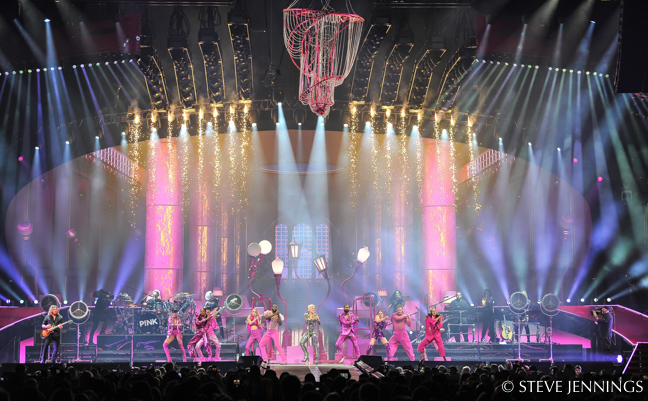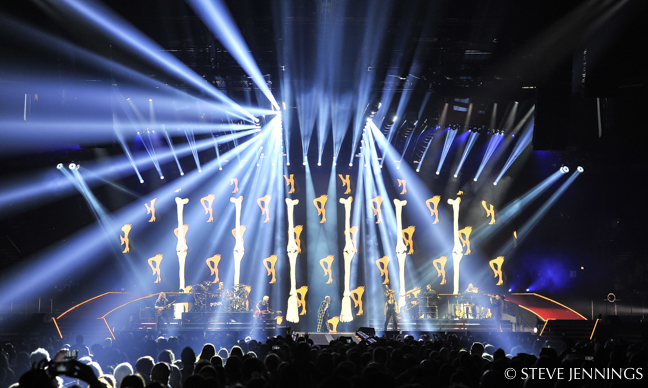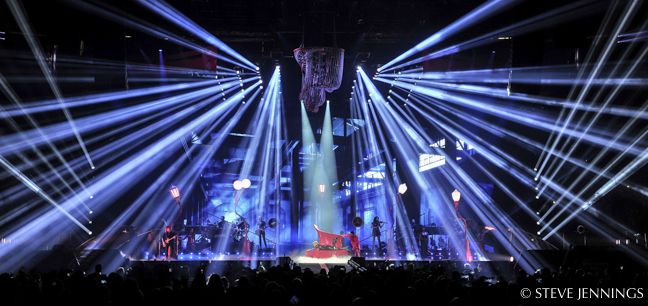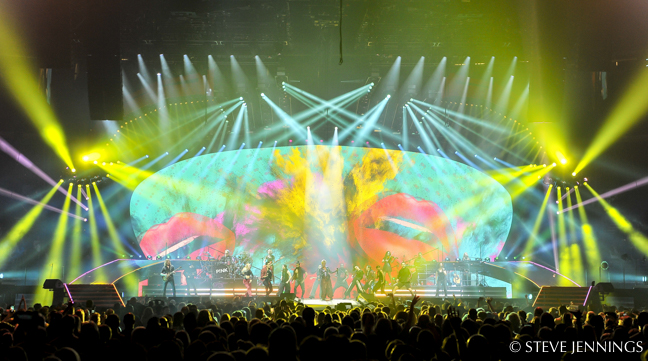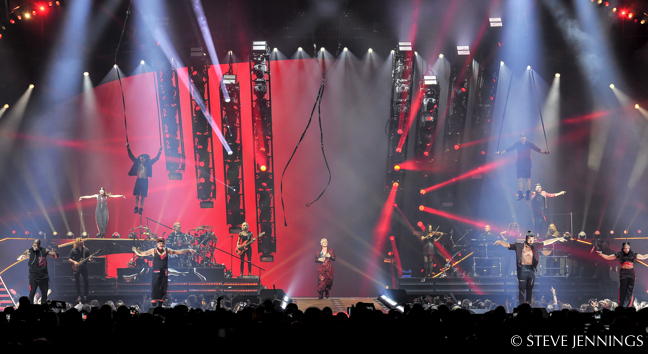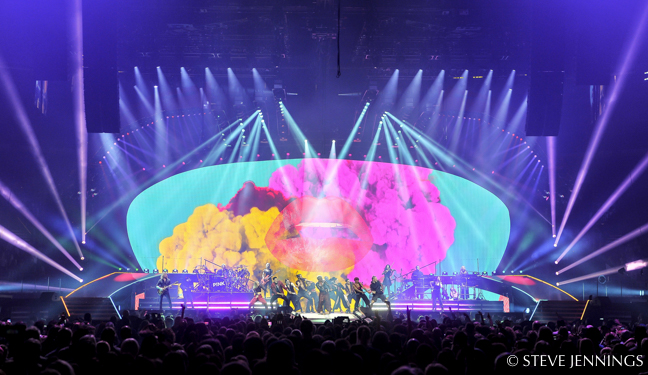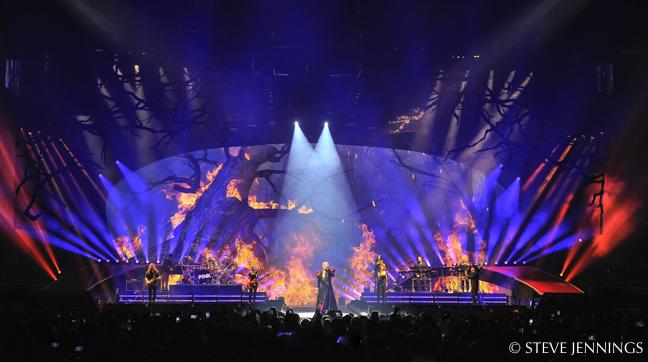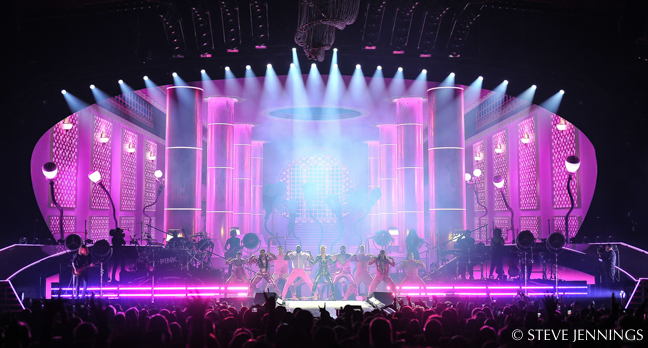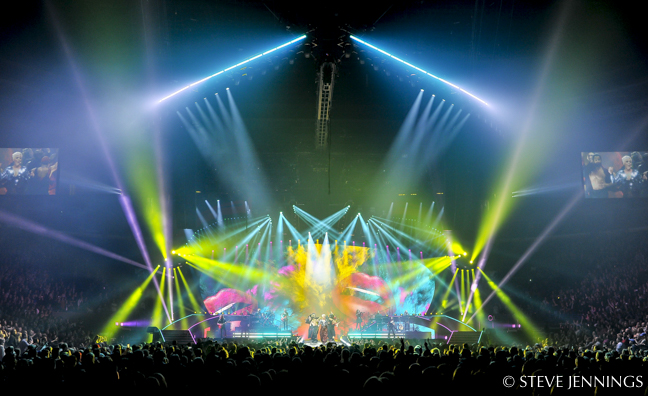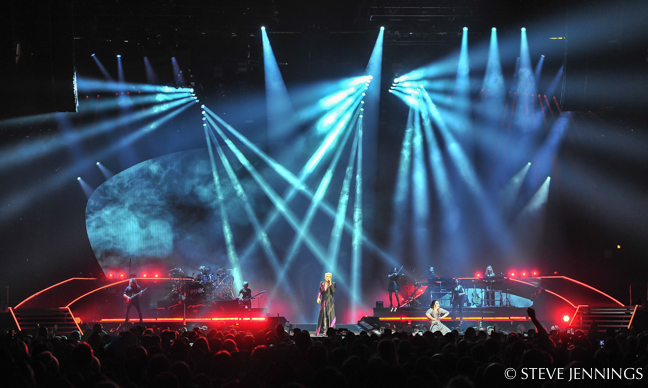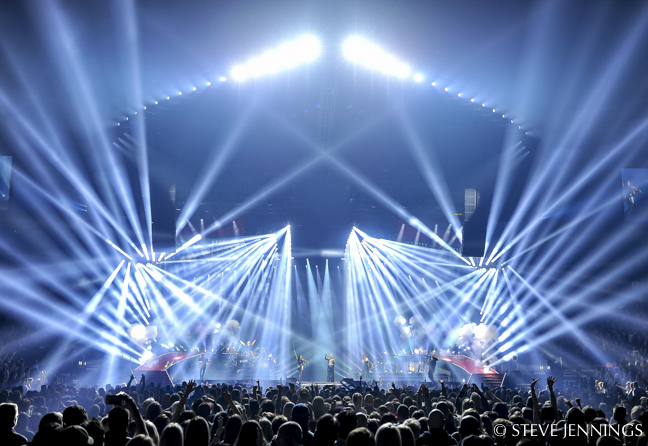
Designer Baz Halpin and Team Create a Stunning Visual Show
The sets were operatic on a Wagnerian level. The dancing was choreographed better than most Broadway shows. The flying and acrobatics were comparable to a Cirque du Soleil experience. There was an epic three-story puppet that seem poised to bust out of the arena.
We must be at a Pink concert.
“For the Beautiful Trauma tour, it was important that the treatment of every song in the show had a beauty and a trauma to it,” Baz Halpin says. “This beauty/trauma theme is expressed throughout the show. The juxtaposition was important.”
With Halpin at the helm wearing multiple hats (lighting designer, set designer, director), you can bet there was plenty of lighting, pyro and imaginative staging happening as well. Tait built the sets and handled the flying, with Pyrotek Special Effects taking care of the flair, which included flames, gerbs and confetti.
Solotech handled the formable video and lighting needs, working with Pink for the first time. “It’s a great opportunity for us,” says vice president of touring Dean Roney. “We have worked with Pink’s production manager Malcolm Weldon for years, going back to when he was with Cher during her early residency at the [Las Vegas Caesars Palace] Colosseum.” It’s also their first time working with Halpin. “We are having a blast,” he says. “He has a great team around him, all great minds.”

Turning the Set List into Acts
“As with every tour I’ve created with Alecia [Pink’s real name], we start with a set list,” Halpin explains. “I put all the songs on cards and start to arrange them in different orders. We break them down into acts that flow well together. While we are doing this, we start to get sparks of ideas which slowly coalesce into concepts.”
The show opened with the drop of a giant pink curtain, revealing an ornate all-pink grand hotel lobby, with Pink hanging from an ornate but slightly twisted chandelier. Some of the highlights of the show included a beautifully dark forest scene, a fun but deadly “revenge land scene” and a barren desert scene for the song “What About Us.” And there’s a lot of dance and a lot of flying, often at the same time. “I worked closely with longtime collaborators and choreographers Nick Florez and R. J. Durell during this early phase so we built all of the concepts and design elements in conjunction with the choreography and aerial choreography.”

There was a particularly compelling moment during the “Just Give Me a Reason” song where Pink flew over the crowd on a giant canopy bed while some of her 10 dancers, also suspended, twirled in the background. For the encore, it was “So What,” where she again flew remarkably close to many in this old hockey arena. A forest seemed to grow in the blink of an eye, complete with a huge tree. The tree was created by an old Hollywood scene shop, complete with a painted canvas that deployed from Chabuki Solenoids. From the opening to the end, the show was heavy in Kabuki/Solenoid, which Halpin admits are “always tricky. We spent a lot of time in rehearsal moving them from place to place to find clean areas for them to drop from an already crowded stage. There is an art to working with soft goods, and it’s always a process.” Vincent Richards of Silent House Productions project-managed all the production design details with the various vendors.
But a highlight that is surely to be seared into the memory of all the concert-goers was the 30-foot-high puppet from Landmark Creations’ Tom Meacham that was a stand-in for Eminem’s portion of the song, “Revenge,” which ended with her demurring a “Thanks, Marshall” as it deflated at the end of the song … you know, after she flew around “Marshall’s” head, kicking it to the delight of the crowd. “We wanted to have Eminem’s portion of the song be played out in a more creative way than him appearing in screen content,” Halpin explains. Silent Partners Studios and Open the Portal worked on the on-screen content that was done in a Claymation style, and then they in turn created the 3D model, which Landmark built the puppet from. “The articulated mouth on the puppet added an extra bit of humor.”

The bulk of the show’s action took place on a heart-shaped runway. “Pink always loves a thrust or a runway and finding new and interesting shapes is always fun,” Halpin says. “For this one, we liked the idea of a heart. And given that her [married] name is Hart, it made sense. It functionally gave us more real estate for lifts, travellators and trap doors, as well as the ability to get props like the flying bed and the puppets to come all the way to the middle of the audience.”
The road from conception to reality is always a journey, not a destination, and that is more so the case for such a grand, imaginative show like this one. “We always go into the planning stages of a tour, knowing that it is a fluid process,” Halpin says. “We overcompensate with the number or songs and the gag ideas too, so that as we go through the rehearsal process we can trim back where it’s needed to help the overall flow of the show. It’s always important to remember the fundamentals: Pink is first and foremost an incredible singer with an incredible band. The flow of the set list, the choice of songs dictate what the gags, looks and choreography will be. If we have a great gag idea but it doesn’t work for a song or doesn’t fit in the set, we don’t do it. We save those ideas that end up on the rehearsal room floor and use them on future performances. We always have more ideas than we can perform in one show.”

The Trussing and Lighting
Key to lighting it all was the unique trussing. “The truss layout of the lighting design came about as an evolution of the aerial and scenic requirements,” Halpin says. “There is only so much overhead real estate, and a requirement for us was to create space for all of the various axes of automation, soft goods and scenic elements. It was then clear that I would need to have a lighting system that could change its position for different songs. Once we had claimed the aerial real estate for the lighting trusses, my associate LD and programmer, Eric Marchwinski, and I started the process of breaking the songs apart and choosing the most appropriate fixtures to populate the rig with.” This involved Claypaky Unicos, which he says became the workhorse of the rig. “We chose Claypaky Mythos 2 as the beam effect fixture, Solaris Flare Qs and LRs as our strobe fixtures, GLP X4s as dancer lights and X4 Bars as built-in set lights. Robe Spikies dotted the risers behind the band and the crane arms in the air. We also placed six [Vari-Lite] VL6000 Beams on the ends of the arms for powerful 3/4 side back lights.”
And speaking of all that aerial work, it of course made her and the dancers that flew a very moving target. Roney says helping keep Pink lit as she flies around are two Follow-Me followspot systems. “One system is tied to the Tait Navigator system for when she flies, and we are able to track her movements and have a large number of lights follow her wherever she goes.” As for those 88 Claypaky Scenius Unicos: “We have previously bought their Scenius Spots and Profiles, as the Scenius is the new ‘Cadillac’ in this business — the Unico adds a large optical aperature, with great results” Roney says.

“The large stage area required precise cuing to ensure we weren’t just blasting light everywhere to bring out the dancers and the action on stage,” Marchwinski adds. “We always take the time to dial in the key light tracking and area lighting to achieve the cleanest looks possible. It is a tedious task at times, but in the end, completely worth the results.” For Marchwinski, the design on this show was interesting as the real estate was built around the acrobatic and automation systems in place. “On many shows in the past we have had many systems of the same types of fixtures, yet here we had a little more variety due to the physical hanging positions,” he says. “The ‘paintbrush’ approach here poses some challenges artistically, as it’s often easy to just turn everything on. The first step was to verify which fixtures worked best as key and area light, and then determine which fixtures were going to help inject musicality into the look.”
Each of the fixture types, including the pods, the arms, the heart etc., all had their own aesthetic and needed to mesh. “In many numbers, we would choose to feature some systems over others, and we were able to thematically follow the aesthetic of each act.”
Upstage of everything is a massive 6mm, 70-by-30-foot video screen made from Solotech’s proprietary LED product built by Saco in Montreal. Tim Jones is the video chief and Matt Lavallee is the lighting chief.

Catwalks and Flight
Tait built the rectangular-shaped stage surrounded by an illuminated heart-shaped runway with two catwalks jutting into the audience and connecting at a point that made for a fan pit. “The heart-shaped catwalk is built from custom Tait Mag Decking with an RGB LED neon edging/outline,” says senior project manager Brian Levin. “We built two custom trap doors that allowed dancers to make entrances and exits in the downstage area of the heart thrust from below the stage.”
The Tait Navigator operated the performer flying package, and there were two flying systems: a 3D Flight Rig and a 9-Axis Acrobatic Rig. The combination allowed Pink to take flight at various onstage and offstage locations and interact with scenic props while flying. Her traditional performer flying system, the 3D Flight Rig, is suspended by four Big Tow Winches and flies Pink at a maximum of 20 feet per second around the perimeter of the arena. But for the majority of the flight paths, the 9-axis Acrobatic Rig was used.
The Acrobatic Rig consists of a trolley system equipped with a custom rotator and a pair of T-Winches that track the length of the stage. An additional trolley system, also outfitted with a pair of T-Winches, tracks perpendicular to the Acrobatic Rig’s trolley system and is followed by a single T-Winch downstage. The Acrobatic Rig can lift Pink and her scenic props up/down at 10 feet per second and track upstage/downstage or stage right/left at 5 feet per second.

“Pink is a very experienced aerialist, but this absolutely required months of practice,” Levin says. “We had winches and a Tait Navigator Automation Console in rehearsals months prior to actual show rehearsals. This allowed the artist, dancers and choreographers to practice on actual automated rigging and allowed our team to begin to program some of the movements.”
In addition to the performer flying systems, the overhead rigging grid has two massive, mechanical arm-like lighting pods and several articulating lighting trusses, which are suspended by 34 Nav Hoists. There are 108 Kabuki Solenoid units installed in the rigging grid to drop Kabuki drapes at various times during the show. Tait Navigator cues the lighting trusses and lighting pods to move up and down and also cues the Kabuki Solenoid units to deploy. Below the rigging grid is a 76-foot-wide main stage surrounded by a fluorescent pink, heart-shaped runway thrust made of LED lit ramps, walkways and staircases. The multi-dimensional stage is also furnished with two performer lifts, two prop lifts, two treadmills and band risers.

“The project as a whole is one of the more technically complex touring shows out there,” Levin adds. “We’ve got custom staging, integrated LED edging, elevators, multiple performer flying winches that lift and track, a four-way 3D winch system that moves the artist all over the arena and audience, and Tait Navigator keeping everything tied together.”

Reid Derne of Pyrotek says that added to all of that is 12 Salamander units, DMX controlled; two Silent Storms of “leaves” (confetti) for the powerful forest scene; a 30 x 30 gold gerb waterfall; close to 100 comets, mines and flashes; and Low Smoke Generators for the low-lying smoke effects. “The greatest part about working with Baz and his team is their ability to know exactly what they are looking for in regard to Special Effects,” Derne says. “With them, there are no ‘gray lines’ to read between. Baz comes up with the vision, and it is my job to make it happen for him. The wealth of knowledge that he has on his staff makes this a smooth process.” Like every other part of Baz’s show, the special effects aren’t mere eye-candy, but tools to tell a story. “With all the elements that are going on with this show, I believe the pyro is a tasteful addition to contribute to the powerful performance that Pink is delivering night after night,” Derne adds.

A Full-Sized Spectacle
Bringing it all to life night after night (and it is a grueling schedule) is lighting director Steve Schwind, which he does on his grandMA2 console. “It’s reliable, and I trust it to get us through any situation that presents itself. Plus, the support from ACT is always on point. Love those guys.”
Steve previously worked with Christina Aguilera, Cher and Taylor Swift, and this is his third tour with Pink. “It’s a very complicated and more theatrical-based show than your usual pop show,” he says. “The set list stays the same, for the most part. Alecia has a few places she can bring guests up, or throw a curve ball to us during the show!” And he confirms that there is no “B” rig to go into a smaller place — it’s this show or nothing … at least for now. “Thankfully because of the group of individuals that are touring this rig, we haven’t/won’t come across anything that would stop us from being able to do this show at its fullest potential.”

This is Schwind’s first tour with Solotech as the vendor. “Dean Roney and Solotech have provided an amazing group of lighting guys/gals and gear,” he says. “There’s no BS, all bad asses. These guys come in and are presented with different obstacles every day, that they look right at, and go right over them! I don’t think this could have been done with any other group.”

“Any tour of this size can be challenging, but the professionalism in the tour management and great direction from Baz’s team made it easy,” Roney says.
Asking Halpin for a favorite moment is akin to asking a parent which child is their favorite, but he does give us one: “I thought the forest scene turned out really well,” he says. “I love working with soft goods and old school theatrical scenery. The chandelier as an aerial apparatus worked really well, and I love the part of the show when the band all come downstage and perform three songs on the tip of the heart. It really shows off the musical and vocal talent that drives the show.”
Pink Beautiful Trauma Tour
Crew
- Production Designer: Baz Halpin
- Associate LD/Programmer: Eric Marchwinski
- Lighting Director: Steve “Six” Schwind
- Lighting/Video Co: Solotech
- Lighting Crew: Matt Lavallee, Anthony Michon, Dany Yockell, Sarah NG, Tony Cerasuolo, Leo Dumont-Frenette, Gabi Scheff, Steve Gertsman
- Account Rep: Dean Roney
- Video Director: Larn Poland
- Video Crew: Tim Jones, Rob Brewer, Brian Henson, Austin Wavra, Gavin Thomson, Nate Fountain, Kevin Paul
- Pyro Co: Pyrotek Special Effects
- Pyro Crew: Reid Derne, Nickolas Zangari, Bernard Walker
- Sets/Automation: Tait
- Inflatables: Landmark Creations/Tom Meacham
- Automation Crew: Russell Macias, Josh Levin, Leonardo Baca, Jason Jones
- Riggers: Gabe Wood, Paul Sapsis, Chuck Sage Anderson, Shawn Gibson, Daniel Porter, Steve Davidson
- Carpenters: John Williamson, Eric Duheaney, Chris Woo, Martin Capiraso, Jason Starr, Willie Adams
- Tour Coordinator: Bill Buntain
- Road Manager: Nancy Shefts
- PM/Head Box Pusher: Malcolm Weldon
- Production Coordinator: Derek Wilson
- Assistant Prod Coordinator: Clarence Gaoiran
- Stage Manager: Greg Bogart
Gear
- 3 grandMA consoles
- 118 Claypaky Mythos 2 fixtures
- 88 Claypaky Scenius Unicos
- 92 Robe Spikies
- 8 Robe Patt 2017
- 6 Robe BMFL Spots
- 36 Chroma-Q Color Force II 72
- 36 Solaris Flare LR
- 32 Solaris Flare Q+
- 24 GLP impression X4 Bar 20’s
- 16 GLP impression X4’s
- 7 Vari-Lite VL6000 Beams
- 63 Tait LED Deck Trim
- 40 Integrated Prop LED
- 3 MDG TheOne foggers
- 2 Martin ZR44 foggers
- 900 Solotech/Saco 6mm LED panels
- 6 Christie projectors
- 1 Grass Valley Karrera
- 6 Grass Valley HD LDX86 cameras
- 2 disguise GX2 servers
More Pink ‘Beautiful Trauma’ tour photos by Steve Jennings:





